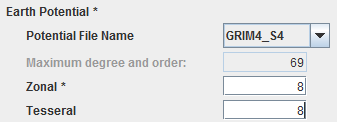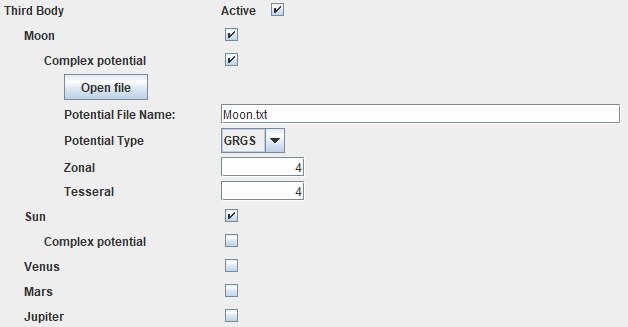Forces
This tab will allow determining which forces (and the associated models) will be applied in the propagation.
Sommaire
Potential
First, of course, the user has to select a potential model (it is mandatory). To do it, the user will simply select the name of the model then the zonal and tesseral degrees and orders. Note that the tesseral order may not be lower than the zonal degree.
By default GRIM4_S4 with 0x0 degree/order (so Keplerian motion) is selected.
Note: in V11.0, we have also to select between Droziner/Balmino/Cunningham equation and Droziner (by default value) does not support 0x0 degree/order.
Third bodies
The user can select which other body will interact with the trajectory thanks to its potential attraction. Of course, the user can select several of these bodies (as Sun and Moon for example). Since V11.6.x, there is the possibility to use complex potential fields.
Atmosphere
Four models are available:
- Exponential (the simplest one)
- MSISE2000
- US76 (average 45 North latitude model thus depending only on the altitude).
- DTM2000
For both MSISE2000 and DTM2000 models, the user will have to enter solar activity information with these three possibilities:
- The real one, stored inside [PATRIUS_DATASET] meaning that the propagation period must correspond to existing data
- A constant flux and geomagnetic index
- A variable flux and geomagnetic index read in a specific file (see [PATRIUS] documentation for the file format). Such kind of files already exist inside the psimu-xx.x-jar-with-dependencies.jar. To get them, you may :
- open it using any tool an application allowing to work with compressed files as 7-Zip
- then go inside the archive in the fr/cnes/sirius/addons/patriusdataset/atmosphere/solar-activity directory => you will see two files (ACTSOL.act corresponding to the "real one" and ACSOL_TRANSLATE.act corresponding to 11 years cycle translated data)
- so, you just have to extract the file(s) from the archive ...
It is also possible to get other files extracting from this zip file here.
Moreover, for these two models, we will need Sun ephemeris (choice displayed at the end of the tab).
Solar radiation pressure
If the user has selected such kind of force, he will have to keep or modify specific data linked to it:
- Reference distance to the Sun (1.4959787E11 m By default)
- Reference pressure (4.5605E-6 N/m2 by default)
- Multiplicative coefficient (1. by default)
If we select this option, we will need, as for some atmosphere, Sun ephemeris (choice displayed at the end of the tab).
Rediffused solar radiation pressure
The user will just have to select or not if albedo and/or infrared component will be taken into account and, if yes, a multiplicative coefficient. If we select this option, we will need, of course, Sun ephemeris (choice displayed at the end of the tab).
Ocean and terrestrial tides
For ocean tides, the use will have to enter several specific data (see [PATRIUS] documentation) as for terrestrial tides, only selection will be necessary.





